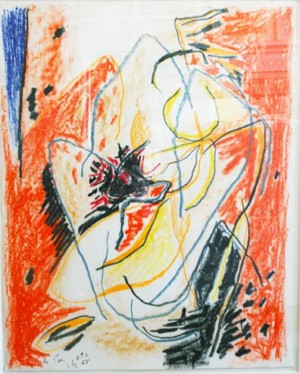Gustave Singier was a Belgian non-figurative painter working in Paris as part of the Lyrical Abstraction and the Salon de Mai. He was a founding member of the Salon du Toulon and the Salon de Vitry-sur-Seine and is buried in Montparnasse Cemetery, a burial place of many of Paris’ intellectual and artistic elite.
Singier was born on February 11, 1909 in Warneton, Flanders in Western Belgium to furniture maker Gustave-Henri Sangier and Germaine Casier. In 1919, when Gustave was ten, the Singier family moved to Paris, France and Gustave was enrolled at the ecole Saint-Sulpice. Gustave’s first studies in painting began in 1923 when he entered the École Boulle. His early artistic education consisted of drawing from nature and copying the works of old masters to develop his drawing and painting skills.
Upon completion of school he began working as a shop and apartment designer for Frederick Sage, a shop building company, which created many aircrafts during both World Wars. Gustave Singier remained with them until 1939. While working for Frederick Sage, Gustave continued to paint developing his skills as an artist. During this time also he met and was married to his wife Raymonde.
In 1936, a conversation with his artist friend Charles Walch, led Gustave into the art world and launched his career in painting with his first show held at the Salon d’Automne, a venue which showcased innovations and developments in painting and sculpture. In 1939 his pieces were shown at the Salon des Tuileries, another important annual exhibition in Paris. Singier also became acquainted with Alfred Manessier, a non-figurative painter, stained glass artist and tapestry designer, with whom he had much in common.
In 1940, Gustave Singier was mobilized into the Belgian Army to fight in World War II. He was deployed to Bagnols-sur-Cèze, but his military career was relatively short as by 1941 he was employed at his father’s furniture shop where he continued to work until 1944. At that time he took shelter in the house of Alfred Manessiere along with several other artistic and intellectual friends. He also continued to display his work during the war years in the Salon des Tuileries, the Galerie de France, Paris and the Salon d’Automne. He also exhibited in the first show of avant-garde painting during the occupation of France, the “Twenty Painters in the French Tradition” show at the Galerie Braun organized by Jean Bazine and Andre Lejard.
After Armistice was signed, Gustave Singier returned to Paris. He returned to painting but his paintings began completely abstract, featuring flat patchwork patterns of bright colors. Within a year of the cease-fire, Singier exhibited within the Salon de Mai, a new salon for young independent painters. He was actively involved in the Salon for most of his life and remained a member of the Board until the time of his death. That same year he was commissioned with LeMoal and Manessier to decorate the Center for Repatriated Prisoners in Thionville, Luxembourg.
In 1947, Gustave Singier became a naturalized citizen of France and met and became friends with the poet Jean Lescure. He continued to display his work within post-war France. Singier had his first solo exhibition in the Galerie Billiet Caputo, Paris in 1949.
In 1951 Singier was made a professor at the Academie Ranson and is named head professor of the painting department of the Ecole National Superieure des Beaux-Arts, which he held until 1978. Singier is mainly remembered as a non-figurative painter in watercolor and oil, but he worked in several other media including etching and lithography and designed pieces in stained glass and tapestry. Singier also designed set and costume pieces for several productions including Marivaux’s “L’Heureux Stratagem” and Sophocle’s “Antigone” both held in 1960 at the Theatre National Populaire.
Singier’s post-war work was very influential to the Lyrical Abstraction style, popular from 1947 to 1957 and in the 1970’s, when it experienced a revival. Lyrical Abstraction was created in response to and opposed many of the other styles of modern art including the “l’Ecole de Paris”, Cubism and Geometric Abstraction. The term Lyrical Abstraction was coined by Georges Mathieu, when he organized an exhibition entitled “Abstraction lyrique,” but the style is also sometimes classed “tachisme”. Major venues for this style include the galleries Arnaud, Drouin, Jeanne Bucher and the Galerie de France, where Singier showed in many times.
In the later part of his life, Singier helped to found many new galleries including the Salon du Toulon in 1975 and the Salon de Vitry-sur-Seine in 1976 with Camille Bryen, Louis Chavagnier, Ladislas Kijno and Felix Labisse among others. He also actively exhibited in France and began showing his work internationally with pieces in the Venice Biennial and Guggenheim in 1954, and exhibiting his work in Tokyo, Moscow and many other cities. He died on May 5, 1984.
Showing the single result
-
$0.00


